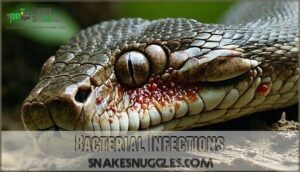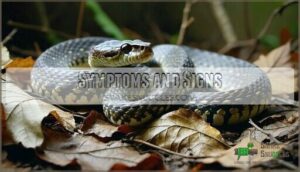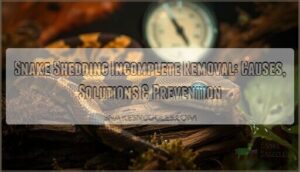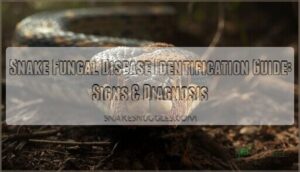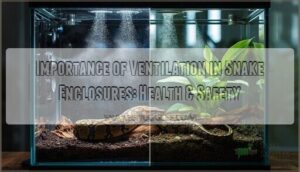This site is supported by our readers. We may earn a commission, at no cost to you, if you purchase through links.
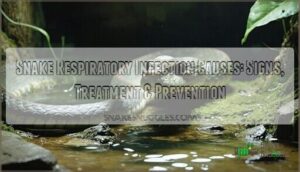
You’ll often see these infections tag-team with mouth rot, creating a double whammy for your scaly friend.
Viruses, fungi, and parasites can also trigger respiratory problems by weakening your snake’s natural defenses.
Poor husbandry is usually the culprit behind these infections – think dirty enclosures, wrong temperatures, or stress from overcrowding.
It’s like leaving your front door open during flu season.
Your snake’s breathing becomes labored, and you might notice mouth breathing or discharge.
Understanding these triggers helps you spot trouble early, and recognizing the role of poor husbandry and immune system compromise is crucial for prevention.
By being aware of these factors, you can take steps to protect your snake’s health and prevent respiratory infections.
Table Of Contents
- Key Takeaways
- Causes of Snake Respiratory Infections
- Bacterial Infections
- Viral Infections
- Fungal Infections
- Parasitic Infections
- Predisposing Factors in Husbandry and Environment
- Symptoms and Signs
- Copious Frothy Discharge From The Mouth
- Watery Discharge From The Nares and Eyes
- Open Mouth Breathing
- Frequently Asked Questions (FAQs)
- What causes respiratory infections in snakes?
- What causes respiratory distress in snakes?
- What causes respiratory infections in reptiles?
- Why does my snake have a sinus infection?
- Do snakes have respiratory problems?
- Why does my snake have pneumonia?
- What is the leading cause of respiratory infection?
- How to treat respiratory infections in reptiles?
- How do animals get respiratory infections?
- How much does it cost to treat a snake with a respiratory infection?
- Conclusion
Key Takeaways
- You’ll deal with bacterial invaders like Pseudomonas and E. coli most often – these gram-negative bacteria exploit your snake’s weakened immune system and create severe respiratory distress, especially when poor husbandry opens the door for infection.
- Your snake’s environment directly causes most respiratory problems – dirty enclosures, wrong temperatures, improper humidity levels, and poor ventilation create perfect breeding grounds for pathogens that’ll attack your pet’s respiratory system.
- You can spot trouble early by watching your snake’s breathing patterns – look for open-mouth breathing, wheezing sounds, watery discharge from the nose and eyes, and frothy mouth discharge as clear warning signs of respiratory infection.
- You’ll prevent most infections by maintaining proper husbandry practices – consistent temperatures between 75-85°F, humidity levels at 40-60%, clean enclosures with good ventilation, and stress reduction will keep your snake’s immune system strong enough to fight off respiratory threats.
Causes of Snake Respiratory Infections
Your snake’s breathing troubles can stem from several sources, including bacteria like Pseudomonas and E. coli, viruses such as nidovirus, fungi like Aspergillus, or parasites including roundworms.
Poor husbandry conditions—think dirty tanks, wrong temperatures, or stress from too much handling—often create the perfect storm for these troublemakers to take hold in your pet’s respiratory system.
This situation can be exacerbated by factors such as poor environment and stress, ultimately leading to severe health issues in snakes.
Bacterial
Several bacterial culprits cause snake respiratory infections, with gram-negative bacteria leading the charge. Your snake’s weakened immune system opens the door for these opportunistic invaders, often resulting in bacterial pneumonia or secondary infections.
As many as 5.6% of snake owners reported respiratory issues in their snakes according to a 2019 study.
Common bacterial troublemakers include:
- Pseudomonas and Klebsiella – aggressive gram-negative bacteria causing severe respiratory distress
- Mycobacteria species – chronic infections requiring extended antibiotic treatments
- Salmonella – potential zoonotic risk with growing antibiotic resistance concerns.
Poor husbandry can lead to ulcerative dermatitis, increasing the risk of respiratory issues.
Viral
While bacteria aren’t the only culprits, viral infections pack a serious punch in snake respiratory disease.
Nidovirus specifics show these pathogens cause severe pneumonia outbreaks.
Paramyxovirus strains hit vipers and boas hardest, creating lung inflammation.
Reptarenavirus impact includes both breathing problems and neurological symptoms in pythons.
Your snake might carry viruses without showing symptoms initially.
One such virus to be aware of is reptarenavirus in boas, which can be carried asymptomatically for years.
Here’s what you need to know about snake viral infections:
- Viral Load: Higher virus amounts mean worse respiratory infection causes and symptoms
- Viral Shedding: Infected snakes spread viruses through breathing secretions
- Herpesvirus Latency: Some viruses hide dormant until stress triggers outbreaks
- Reovirus Shedding: Multiple viral infections often occur together, worsening snake viral disease
Fungal
Fungal infections strike when your snake’s immunity gets compromised.
**Fungal invaders exploit every weakness in your snake’s defenses, turning minor immunity gaps into major respiratory disasters.
Snake fungal disease and Aspergillus impacts create serious respiratory problems, forming lung granulomas that block airflow.
These opportunistic fungi thrive in poor conditions with high humidity and inadequate ventilation.
Treatment requires antifungal medications like itraconazole, but prevention through proper husbandry beats fighting established fungal infections every time.
Parasitic
Parasitic infections often fly under the radar until they’ve wreaked havoc on your snake’s respiratory system.
Lungworms, coccidia, flatworms, and **Strongyloides spp.
** invade airways, causing inflammation and breathing difficulties.
These sneaky invaders spread through contaminated prey or poor enclosure hygiene.
Effective parasite prevention requires fecal testing, proper quarantine protocols, and anti-parasitic treatments targeting specific organisms.
Risk Factors
Your snake’s vulnerability to respiratory infections increases when specific risk factors stack up like dominoes.
Poor husbandry practices, inadequate hygiene standards, and temperature fluctuations create perfect storm conditions.
Handling stress weakens immunity, while poor ventilation quality traps harmful pathogens.
Without proper quarantine protocols, new additions can introduce disease.
Environmental factors and substandard reptile environment management substantially elevate infection risks, making proper management crucial.
Diagnosis & Treatment
Identifying snake respiratory infection requires diagnostic imaging like X-rays to spot lung inflammation.
Your vet will combine physical exams with lab tests for accurate diagnosis.
Antibiotic treatments target bacterial causes, while supportive therapies maintain proper temperature and hydration.
Many owners purchase snake antibiotics for treatment.
Treatment duration typically spans 2-4 weeks, though prognosis factors depend on early detection and consistent care for reptile respiratory disease recovery.
Bacterial Infections
Multiple bacterial species can turn your snake’s breathing into a real struggle. Gram-negative bacteria like Pseudomonas often lead the charge, while mycobacteria impact can create long-term health issues.
Secondary infections frequently follow initial respiratory problems, making recovery harder. Antibiotic resistance poses growing challenges for treatment success. Snakes experiencing these issues may show signs of respiratory distress.
- Mycoplasma Species: These sneaky bacteria colonize respiratory tracts without obvious symptoms initially
- Environmental Opportunists: Poor husbandry allows harmful bacteria to multiply rapidly in enclosures
- Cross-Contamination: Bacterial respiratory diseases spread quickly between snakes in collections
- Treatment Complexity: Effective preventative measures require proper diagnosis and targeted antibiotic therapy
Viral Infections
Several viral culprits can trigger serious snake respiratory infections, turning your pet’s breathing into a real struggle.
Nidovirus specifics include severe pneumonia outbreaks, while Paramyxovirus strains cause deadly hemorrhaging in lung tissue. Herpesvirus effects vary widely, and Reovirus impact often goes unnoticed until it’s too late.
You’ll spot inclusion bodies during lab tests, confirming viral diseases are wreaking havoc. These snake breathing problems start subtly—watch for increased respiratory effort and unusual mouth positioning.
Early detection of snake illness symptoms makes all the difference in your reptile’s recovery chances. It is crucial to identify these symptoms to prevent severe damage, and understanding the role of viruses like Herpesvirus is key.
Fungal Infections
While viral pathogens wreak havoc on your snake’s system, fungal infections present an equally serious threat that’s often harder to spot initially.
These sneaky invaders exploit any weakness in your pet’s immunity, turning environmental fungi into dangerous respiratory pathogens.
Snake fungal disease and Aspergillus impact your snake’s breathing through these warning signs:
- Open-mouth breathing indicates severe respiratory distress
- Watery discharge from nares signals fungal invasion
- Increased respiratory rate shows compromised lung function
- Lethargy suggests systemic fungal spread
- Reduced appetite accompanies respiratory infection symptoms
- Pulmonary granulomas develop in advanced cases
- Poor environmental conditions promote fungal growth
Your snake’s enclosure becomes a breeding ground for trouble when humidity climbs too high or ventilation fails.
Snake respiratory infection from fungi demands immediate professional intervention since these organisms create stubborn infections that resist simple remedies.
Antifungal treatments require veterinary prescription for effectiveness.
Parasitic Infections
Parasites wage silent warfare inside your snake’s respiratory system, causing serious breathing problems.
These microscopic invaders include roundworms, coccidia, flatworms, and specialized lungworm species that complete their lifecycle directly in lung tissue.
Coccidia transmission occurs through contaminated environments, while flatworm effects include tissue damage and secondary infections.
| Parasite Type | Common Species | Treatment |
|---|---|---|
| Roundworms | Strongyloides, Rhabdias | Ivermectin, fenbendazole |
| Lungworms | Raillietiella orientalis | Targeted anti-parasitic drugs |
| Flatworms | Trematodes | Praziquantel combinations |
| Coccidia | Entamoeba species | Supportive care, quarantine |
Snake mites (Ophionyssus natricis) act as vectors, spreading infectious causes of pneumonia.
Roundworm treatment typically involves ivermectin or moxidectin.
Effective parasite prevention requires strict quarantine protocols and regular fecal examinations to catch snake parasitic disease early.
Predisposing Factors in Husbandry and Environment
Your snake’s home environment plays a bigger role in respiratory health than you might think, kind of like how a messy bedroom can make you feel stuffy and uncomfortable.
Poor husbandry practices such as incorrect temperatures, wrong humidity levels, dirty enclosures, and inadequate ventilation create the perfect storm for respiratory infections to take hold in your pet snake.
Husbandry and Health
Poor snake husbandry creates a perfect storm for respiratory infections. Your snake’s health depends on getting the basics right from day one.
Essential husbandry practices include:
- Quarantine protocols – isolate new snakes for 30-60 days before introducing them
- Stress reduction – minimize handling and maintain consistent routines
- Nutritional support – provide species-appropriate diets and supplements
- Preventative care – schedule regular veterinary checkups
A vital step involves using a dedicated enclosure for new arrivals.
Environmental Cleanliness
Why does your snake’s home look like a disaster zone? Dirty enclosures create perfect breeding grounds for respiratory pathogens that’ll make your scaly friend miserable.
Proper enclosure sanitation isn’t rocket science, but it’s absolutely essential for snake husbandry success.
Here’s your cleaning game plan:
- Daily waste removal – Spot-clean immediately when you see mess
- Weekly deep cleaning – Use reptile-safe disinfectant choices on all surfaces
- Monthly substrate selection – Replace bedding completely to maintain air quality control
Using a proper reptile habitat cleaner is vital for their health. Consistent enclosure maintenance prevents most respiratory headaches before they start.
Temperature and Humidity
Your snake’s temperature and humidity levels directly impact respiratory health. Ideal gradients between 75-85°F prevent immune suppression, while humidity control methods maintaining 40-60% reduce infection risk.
Environmental factors like sudden temperature changes stress your snake’s system. Enclosure ventilation prevents stagnant air, and humidity monitoring prevents shedding issues.
Species differences mean you’ll need species-specific requirements to avoid snake respiratory infection. For corn snakes, owners should aim for 65-75% humidity to promote healthy shedding.
Symptoms and Signs
You’ll notice your snake’s breathing changes before other symptoms appear, making early detection your best defense against respiratory infections.
Watch for wheezing sounds, mouth breathing, or visible rib movement during breathing, as these signs often show up days before your pet stops eating or becomes lethargic, which can be a clear indication of a serious issue, emphasizing the importance of early detection.
Respiratory Rate
Watch for changes in your snake’s respiratory rate during a respiratory infection.
Healthy snakes breathe slowly and steadily, but sick ones breathe faster. Rate changes signal trouble—you’ll notice quicker chest movements or visible effort.
Species variation affects normal rates, so know your snake’s baseline. Stress impact from illness makes breathing irregular.
Count breaths to track improvement during treatment.
Effort and Signs
Beyond normal breathing patterns, your snake’s respiratory infection signs become quite obvious. Labored breathing with visible rib movement signals distress, while breathing sounds like wheezing or gurgling indicate serious trouble. Open-mouth breathing means your pet’s struggling for air.
- Nasal discharge – mucus or colored fluid from nostrils
- Lethargy signs – reduced activity and appetite loss
- Aquatic symptoms – uneven floating in water snakes
- Early detection – prevents severe respiratory complications
Diagnosis
Getting to the bottom of your snake’s breathing troubles requires detective work by your vet.
The physical exam comes first, where they’ll listen for wheezing and check for discharge.
Blood work reveals infection severity, while fecal analysis rules out parasites contributing to respiratory infection signs.
Radiographic findings from X-rays show lung inflammation or fluid buildup.
For tricky cases, advanced diagnostics like CT scans or lung washes provide deeper insights.
PCR testing identifies specific pathogens causing the snake respiratory infection.
| Diagnostic Method | Purpose |
|---|---|
| Physical Examination | Assess breathing patterns and discharge |
| X-ray Imaging | Visualize lung structures and inflammation |
| Blood Testing | Determine infection severity |
| PCR Testing | Identify specific respiratory pathogens |
Early diagnosis means faster treatment and better outcomes for veterinary care.
Copious Frothy Discharge From The Mouth
Thick, frothy discharge bubbling from your snake’s mouth signals serious respiratory distress that demands immediate attention. This foamy secretion differs from normal saliva in its discharge composition – it’s typically white or clear with a bubbly texture that indicates fluid accumulation in the lungs.
When your snake’s mouth froths like a cappuccino machine, it’s screaming for emergency veterinary care.
During oral examination, you’ll notice this frothy material coating the mouth and sometimes the glottis. The aspiration risk increases substantially when snakes can’t clear these secretions properly, potentially worsening their snake respiratory infection.
Differential diagnosis includes bacterial pneumonia, viral infections, or fungal disease – all producing similar respiratory infection signs. Don’t confuse this with simple nasal discharge or openmouth breathing alone.
Treatment options vary based on the underlying cause, but immediate veterinary care is vital. A snake bacterial infection often responds well to antibiotics when caught early, preventing life-threatening complications.
Maintaining proper humidity can help, but clogged nostrils are serious and require prompt attention.
Watery Discharge From The Nares and Eyes
Clear, watery discharge from your snake’s nose and eyes signals respiratory trouble brewing beneath the surface.
This snake respiratory infection symptom often appears alongside other respiratory infection signs, creating a telltale pattern that’s hard to miss.
Discharge Characteristics vary from thin and clear to slightly cloudy.
You’ll notice it around the nostrils first, then possibly near the eyes.
Unlike the thick, frothy mouth discharge, nasal discharge tends to be more watery and consistent.
Underlying Causes include snake bacterial infection, viral pathogens, and environmental stressors.
Poor humidity levels often trigger this response, making your snake’s respiratory system work overtime.
Diagnostic Testing helps pinpoint the exact culprit behind snake respiratory disease.
Your vet might recommend cultures or blood work to identify specific pathogens.
Treatment Options typically involve antibiotics for bacterial causes, while Preventative Measures focus on maintaining proper humidity levels between 40-60%.
Open Mouth Breathing
After noticing watery discharge, you might observe your snake breathing with its mouth open. This open mouth breathing signals severe respiratory distress and demands immediate emergency treatment. When snakes can’t get enough air through their nostrils, they resort to mouth breathing—think of it as their last resort.
Quick severity assessment and differential diagnosis by a reptile veterinarian are essential. Snake respiratory infection signs like labored breathing indicate serious prognosis factors affecting long-term effects.
- Immediate veterinary care prevents respiratory failure
- Oxygen therapy supports severely distressed snakes
- Antimicrobial treatment targets underlying infections
- Nebulization therapy helps clear blocked airways
- Temperature regulation aids the healing process
Frequently Asked Questions (FAQs)
What causes respiratory infections in snakes?
Ever wonder why your snake’s breathing sounds like a broken accordion?
You’re likely dealing with poor husbandry – dirty enclosures, wrong temperatures, or humidity issues create perfect conditions for bacterial, viral, or fungal infections, which can lead to serious health problems for your snake, often resulting from bacterial issues.
What causes respiratory distress in snakes?
Respiratory distress in your snake stems from bacterial, viral, or fungal infections, poor husbandry like wrong temperatures or humidity, dirty enclosures, stress, parasites, or underlying health issues like heart disease.
What causes respiratory infections in reptiles?
Poor husbandry triggers most reptile respiratory infections.
You’ll see problems from dirty enclosures, wrong temperatures, improper humidity, stress, and poor ventilation.
Bacteria, viruses, fungi, and parasites then exploit your pet’s weakened defenses.
Why does my snake have a sinus infection?
Your snake’s sinus infection likely stems from poor husbandry conditions.
Improper humidity levels, inadequate temperatures, dirty enclosures, or poor ventilation create perfect breeding grounds for bacteria and fungi that attack your snake’s respiratory system.
Do snakes have respiratory problems?
Yes, snakes commonly develop respiratory infections from poor husbandry, stress, or pathogens.
You’ll notice wheezing, mouth breathing, nasal discharge, and lethargy.
These conditions require immediate veterinary care and proper environmental management.
Why does my snake have pneumonia?
Your snake’s pneumonia likely stems from improper humidity levels, dirty enclosure conditions, or temperature fluctuations. Bacterial pathogens like Pseudomonas or viral infections exploit weakened immunity from poor husbandry practices.
What is the leading cause of respiratory infection?
Improper husbandry tops the list as your reptile’s biggest respiratory threat.
You’re looking at wrong temperatures, humidity levels, dirty enclosures, and poor ventilation creating perfect conditions for bacterial infections to take hold, which is a result of improper husbandry.
How to treat respiratory infections in reptiles?
You’ll need antibiotics like enrofloxacin from your vet, plus nebulization therapy and supportive care. Fix humidity levels, boost temperatures, and improve ventilation. Recovery takes weeks, so patience is key.
How do animals get respiratory infections?
Animals catch respiratory infections through several pathways: inhaling airborne pathogens from sick animals.
Living in dirty environments with poor ventilation, experiencing stress that weakens immunity, or encountering contaminated surfaces and water sources are other factors.
These pathways can all contribute to the development of respiratory infections in animals.
How much does it cost to treat a snake with a respiratory infection?
Treating your snake’s respiratory infection typically costs $200-800, depending on severity.
You’ll pay for vet visits, diagnostics like X-rays, antibiotics, nebulization treatments, and supportive care.
Complex cases requiring hospitalization cost more.
Conclusion
Ironically, preventing snake respiratory infection causes is far easier than treating them once they’ve taken hold.
You’ve learned that bacteria, viruses, fungi, and parasites all pose threats when your snake’s defenses are down.
Poor husbandry creates the perfect storm for these infections to flourish.
Keep temperatures consistent, maintain proper humidity, and make certain clean living conditions.
Your snake’s breathing patterns tell the story – watch for labored respiration, mouth breathing, and discharge.
Prevention beats treatment every time, and it is crucial to be aware of these signs to ensure your snake’s health.
- https://www.petmd.com/reptile/conditions/respiratory/respiratory-infections-reptiles
- https://pmc.ncbi.nlm.nih.gov/articles/PMC4254391/
- https://journals.sagepub.com/doi/10.1177/03009858231186391?icid=int.sj-full-text.similar-articles.3
- https://familysnake.com/guides/breathe-easy-preventing-respiratory-infections-in-your-pet-snake/
- https://www.merckvetmanual.com/exotic-and-laboratory-animals/reptiles/parasitic-diseases-of-reptiles?query=reptile%20respiratory

